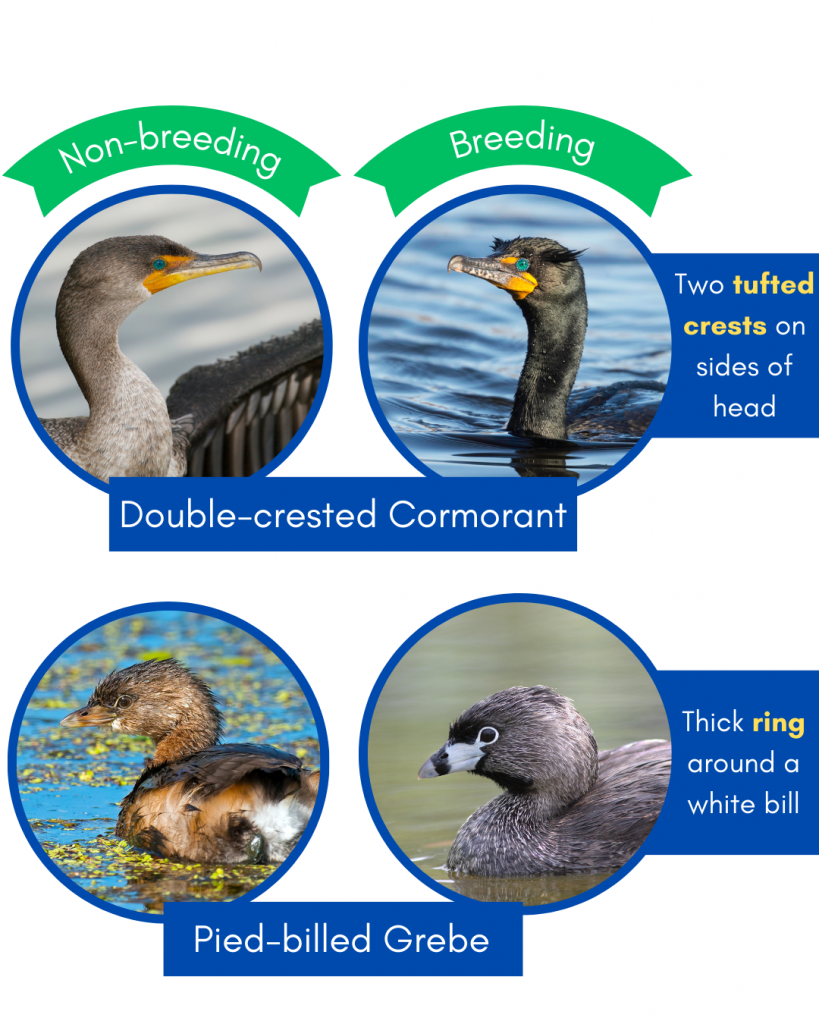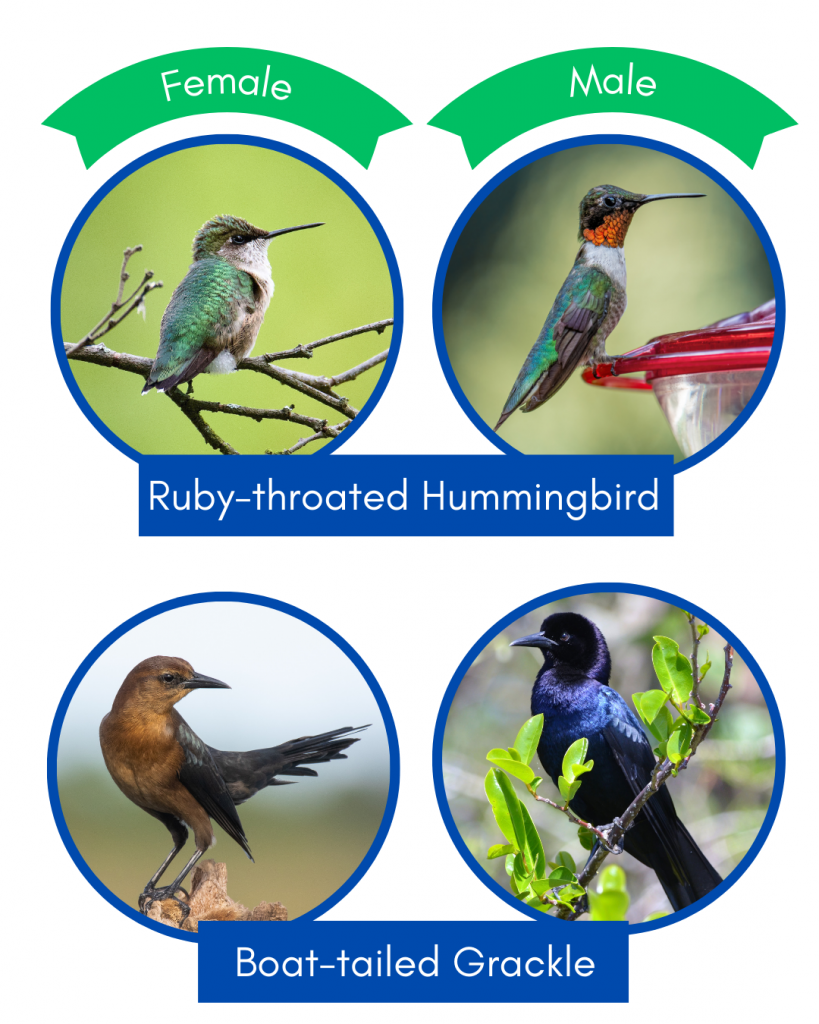What is going on?
If you’ve seen the red flash of a Northern Cardinal in your backyard, or watched a shiny black American Crow hop across the road, then you already know what plumage is! A bird’s plumage is their collection of feathers, and serves many purposes besides just looking beautiful. Fluffy down feathers trap pockets of air close to the body for insulation, while sleek contour feathers streamline the bird for flight. Plumage looks different between bird species, but it can also vary within the same species. In just one species of bird, there may be multiple varieties of plumage that can be seen throughout the year. Plumage can differ between male and female individuals; during different seasons; and even throughout the stages of a bird’s life. Learning about the different plumage that birds display can help us identify them more accurately, and can give us insight into what the birds are communicating to each other– with their feathers!
What is breeding plumage?
As springtime rolls around, so does the start of spring migration and bird breeding season in Florida. Many kinds of birds are beginning to flaunt their colorful feathers to impress potential mates, in a seasonal spectacle of “breeding plumage.” Some birds are more understated than others, with more subtle changes occurring in the shade of their bill or lores, which is the skin surrounding the eyes.
Here are some Florida natives that you may be able to spot in full breeding plumage this spring (click on the images to view them larger).
1. Great Blue Heron
These magnificent birds can reach over four feet tall, and are often found standing statue-like in wetlands as they wait for prey to swim by. During the breeding season, their lores turn from dull, slate blue to bright blue. On the back of their head, long black plumes elongate into a trailing crown.
2. Great Egret
Slightly smaller than the Great Blue Heron, the Great Egret is a snow-white bird that also frequents wetland ecosystems. Around springtime, their lores transform from a dusty yellow to bright, lime green. Feathered white plumes called aigrettes are characteristic of their breeding plumage. Males preen these aigrettes into a lacy fan during their courtship display. These beautiful feathers were unfortunately prized as hat accessories during the late 19th century and early 20th century, which led to sharp declines in Great Egret populations. Today, they have rebounded and are now listed as “Least Concern” by the IUCN Red List.
3. Double-crested Cormorant
Sometimes confused with the Anhinga from afar, the Double-crested Cormorant can be identified by its hooked bill, bright turquoise eyes, and a patch of orange skin on its face. They can be seen in freshwater bodies across North America, diving under the surface to catch fish. During the breeding season, they develop their namesake tuft-like black “crests” of feathers on either side of their head.
4. Pied-billed Grebe
The Pied-billed Grebe is another aquatic bird, common to marshy areas with thick vegetation. During the breeding season, their usually dull bills turn white with a thick black ring.
What is sexual dimorphism?
Seasonal change for courtship and breeding is not the only reason a bird’s plumage may look colorful. Sometimes, sexual dimorphism within a species means that males and females have starkly different plumage year round! Sexual dimorphism does not always refer to plumage– it can also be used when talking about differences in body size, or even shape. While not a clear-cut rule, male individuals of sexually dimorphic species tend to have more colorful or showy plumage than their female counterparts. There are many potential explanations for plumage dimorphism, including breeding systems or even social or environmental changes.
Here are a few birds found in Florida that consistently exhibit sexual dimorphism through their plumage (click on the images to view them larger):
1. Northern Cardinal
The Northern Cardinal is found year-round in Florida, so there’s a good chance you’ve already seen one in your backyard or at a local park. Males are easily identified by their bright red plumage and a black mask around their bill. Females are light brown, with red pops of color on their wing tips and pointed crest.
2. Red-winged Blackbird
It’s likely that you’ve heard the trill of the Red-winged Blackbird if you’ve taken a stroll around a wetland or marshy area in Florida. Many of them congregate in vocal flocks, and males can be spotted perching on tall grasses and reeds. Males are black all over with signature red caps on their shoulders. Females have more cryptic plumage that blends into vegetation, with dark brown streaking all over.
3. Ruby-throated Hummingbird
The Ruby-throated Hummingbird is the most common hummingbird in Florida, arriving at the beginning of spring after spending the winter in Mexico and South America. Both males and females are jewel-green on their backs and heads, with a light gray underbelly. The distinguishing feature between the two is the iridescent red throat patch on males that gives the species its name.
4. Boat-tailed Grackle
Found throughout the Florida peninsula, Boat-tailed Grackles are large songbirds that are often spotted near bodies of water. Both males and females have a signature long, paddle-shaped tail. Males have shiny black plumage that glints blue and purple in the light, whereas females are a warm coppery brown underneath and dark brown on top.
Where to go birding
Learn more about birding in the TESI Feature Article, Expanding the World of Science Through Birdwatching.
Information from American Bird Conservancy, Heron Conservation, BWD Magazine, Cornell Lab All About Birds, Audubon, IFAS. Images from Canva Pro.



